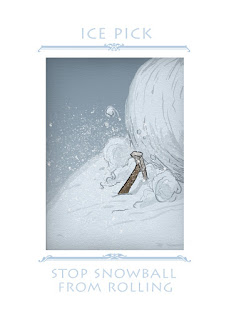I'd like to apologize in advance for the lack of pictures. I don't have this board anymore, so I had to use the very few pictures that I took at the time. :)
The board. The key component for Fireball island and in this case, Yeti Mountain. I didn't really know how to go about creating a three-dimensional, terrain-like, board. There aren't many tutorials on YouTube for creating something of this caliber. So I had to figure it out myself...
A lot went into the creation of the board, so I will try to remember as much of the construction as I possibly can. My first plan for creating the board was to vacuum form my own board. This would require me to have a prototype "mold", a vacuum forming machine and plastic to vacuum form.
Step #1: Creating the prototype mold:
In order to create a vacuum formed game board, I needed to make a physical model of the board. There were two types of boards that I could create, a male part, or in this case board, or a female part. Here is a great website that explains the difference between male Vs. female:
http://www.empirewest.com/thermoforming-male-vs-female.html. When I started the creation of the board, I was not aware about this, so I just decided to buy 20 lbs. of clay and sculpt my own board. Later on, I bought another 20 lbs. from Amazon because I needed a bit more. It's surprisingly cheap!
I started to slap clay onto a wooden board and slowly sculpt it into a terrain. I then added in the pathways and the crossings, where I would place the bridges. I also added in a space where the Yeti would go and little indents for the Snowballs.



I didn't really put much, if any, thought into the layout of the board. I only thought about getting the snowballs to roll properly and made sure that the playing pieces would fit on the board.

I let the board sit in my garage to dry for the vacuum forming process. When I checked on it the first day, I noticed some cracks occurring, I left the cracks because they added a neat, natural texture to the board. When I re-checked the board the cracks became bigger, a lot bigger. Parts of the board where completely decimated. I filled in all the holes with clay, sprayed the board with water and covered it in cling-film. This helped reduce the cracking!


In order to prepare the board for the vacuum forming process, I needed to drill lots of mini holes into the board. This would let the air from the vacuum pass through the board and pull the plastic down, causing it to take shape.
Step #2: Creating the Vacuum Forming Machine:
Making a vacuum forming machine sounds very complicated and impressive, but anyone with some handiwork skills, shouldn't have any trouble! There are many great tutorials on how to create a machine that will vacuum form. And they will also show you how to create a box to heat up the plastic so that it can morph around your object. This is the tutorial that I used:
http://makezine.com/2011/09/08/how-to-large-homemade-vacuum-forming-machine/.
Step #3: Vacuum forming the first board:
I probably should have stated this earlier, but this overall process that I'm explaining at the moment, was a failure. Saying that though, I learned a lot of useful and valuable information that helped me in my future attempts, which I will post about later!
While I was heating up the plastic to vacuum form, I placed the clay model on the vacuum forming machine and turned it on. Once the plastic was very malleable, I placed it on top of the board. It suddenly sucked down and took the shape of the model! At first glance, it looked amazing! I had finally made a 3D board! However on closer inspection, the vacuum was not strong enough, and places such as stair cases were actually slopes. Where there were supposed to be corners, there were curves. Overall, the board wasn't playable.

This wasn't the biggest problem. The power of the vacuum former was strong enough to completely destroy the clay board. This made it unusable for another attempt.


At the time I was very annoyed, but in hindsight, I am very happy this happened. It forced me to have to recreate the board. I realized this after attempting to playtest the board, which was proven to be very difficult because the pieces could hardly stand.

I then decided to create a second board, which will be explained in a later post!
If you have any questions on some of the specifics, please ask and I will try my best to answer them!
If you have any feedback on how I could have improved the design or the overall process, I would love to hear it!
Thanks,
Marlon :)
Yeti Mountain Facebook Page:
https://www.facebook.com/YetiMountainBoardGame/
Prefundia page(Sign up on the email list here!):
http://prefundia.com/projects/view/yeti-mountain/8917/
Twitter:
https://twitter.com/ElementaryCeo
And Now I even have an Instagram :O what!?
https://www.instagram.com/yeti_mountain_the_board_game/


















































